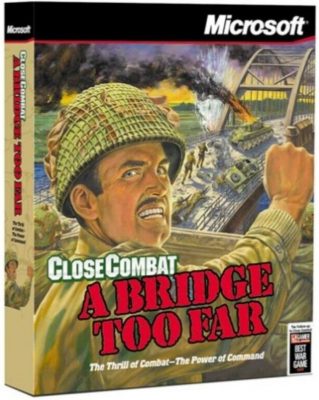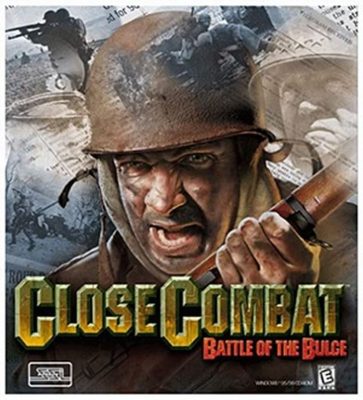25 Year Retrospective of the Close Combat Series (part two)
By Patrick S. Baker
Patrick S. Baker
1996’s Close Combat was a roaring commercial and critical success. Based on that accomplishment, in 1997, Atomic and Microsoft released a direct sequel: Close Combat II: A Bridge Too Far. This follow-on game was set during 1944’s Operation: Market Garden. Close Combat II (CC II) featured not just American and German army units, but also British, Polish and Waffen-SS units.
The game had the same mechanics and modeling as the first Close Combat game, but with better graphics. CC II was as well received as the original game. The two Close Combat titles outsold Atomic Games previous releases by a factor of ten and CC II was Atomic’s most successful game by far, to date.
The game was also favorably reviewed with one reviewer saying that A Bridge Too Far was “improved in every way over Atomic’s original Close Combat.” The game was voted seventh in GameSpy’s “Top Ten Real-Time Strategy Games of All Time”. It was an Editor’s Choice and runner-up as the Best Wargame of the Year from PC Gamer Magazine. It was also a runner-up for Computer Gaming World’s 1997 “Wargame Game of the Year” award. The Computer Game Developers Conference nominated CC II for its “Best Strategy/Wargame Spotlight Award.”

In January 1999, the third Close Combat game, Close Combat III: The Russian Front was released. Unlike the first two games, Close Combat III (CC III), instead of focusing on a single battle, or short campaign, was set on the whole o f the Eastern Front. Scenarios ran from 1941 with Operation Barbarossa, from Moscow, to Stalingrad in 1943, and to Berlin in 1945.
f the Eastern Front. Scenarios ran from 1941 with Operation Barbarossa, from Moscow, to Stalingrad in 1943, and to Berlin in 1945.
The game vastly increasing the scope of the battles, as well as the inventory of units, both Russian and German, available to the player. CC III also added the ability to set a unit in ambush. Ambush mode put the unit into hiding and they only emerged and attacked when an enemy unit was very close. Ambush and the Defend command were now direction sensitive, meaning the unit had a facing. This, and the capability to scavenge enemy weapons and ammo enhanced the realism of the game.
If anything, CC III was better received by both reviewers and the wargaming public than the previous two games. Some sources reported that it was the best-selling war game of the year. Another stated that the game sold “well over 100,000 units” in the first four months of 1999 alone.
One reviewer called The Russian Front, “the best Close Combat game of the bunch and … probably the best war game to grace your hard drive ever.” The editors of PC Gamer US gave CC III their “Best Wargame” of 1999 prize, hailing it as the “strongest Close Combat title yet”. The Academy of Interactive Arts & Sciences  nominated CC III for Best Strategy Game of the Year.
nominated CC III for Best Strategy Game of the Year.
Despite the excellent sales of the three Close Combat games, Microsoft decided that CC III would be the last game of the series they would publish. The software giant elected to focus on “publishing games that have the potential of selling 250,000 units or more.” Unlike the split with Avalon Hill, the breakup with Microsoft was amicable.
Atomic Games now partnered with Strategic Simulations, Inc. (SSI) for the development and publication of Close Combat IV: Battle of the Bulge (CC IV). This fourth installment of the game franchise was released in November, 1999 and portrayed the German winter offensive of 1944 in the Ardennes Forest.
This entry, while still emphasizing the tactical level combat, introduced an operational/strategic layer to the game, requiring the players to move battle-groups around a strategic map. Again, the game sold well and was well reviewed by critics. CC IV was a finalist for Computer Games Strategy Plus’s 1999 “Wargame of the Year” prize. It was also a runner-up for Computer Gaming World’s 1999 “Wargame of the Year” award, but lost out for the top spot because of some “AI quirks and mysteriously reincarnating units”.
Atomic and SSI started to work on the fifth Close Combat game in early 2000. As a result of business trades and mergers Combat V: Invasion: Normandy was published by Mattel Interactive, not SSI. Some reviewers and players lauded the new force management tool where the player could choose up to 15 units to comprise their battle groups, instead of having  fixed types and numbers of units. Others thought CC V lacked innovation, and that it was more of an add-on, rather than a fully realized new game. While sales were still solid, this entry did not make any “the best of…” lists for the major gaming magazines that year.
fixed types and numbers of units. Others thought CC V lacked innovation, and that it was more of an add-on, rather than a fully realized new game. While sales were still solid, this entry did not make any “the best of…” lists for the major gaming magazines that year.
Financial and business problems forced Mattel to sell Atomic’s parent company, The Learning Company. Then, just two months after the release of Invasion: Normandy, Atomic was forced to lay off all of the games’ developers, except the three most senior ones. This left the future of the Close Combat franchise very much in doubt in the new millennium.
However, and perhaps not so surprisingly, the United States Marine Corps soon came to the rescue.
Patrick S. Baker is a former US Army Field Artillery officer and retired Department of Defense employee. He has advanced degrees in History and Political Science. He continues to use all his education and experience to play more games and annoy his family.
